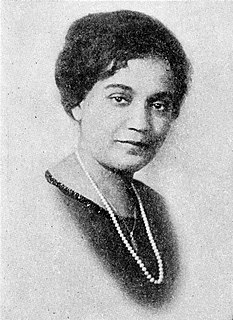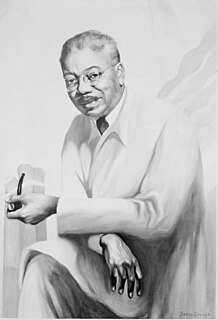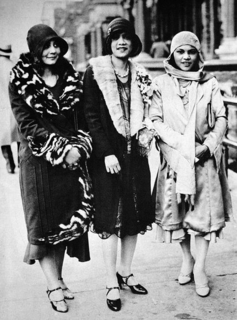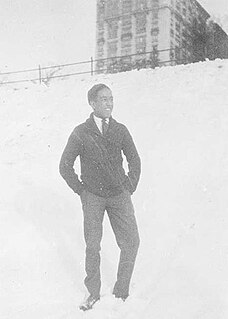Related Research Articles

William Edward Burghardt Du Bois was an American sociologist, socialist, historian, civil rights activist, Pan-Africanist, author, writer and editor. Born in Great Barrington, Massachusetts, Du Bois grew up in a relatively tolerant and integrated community, and after completing graduate work at the University of Berlin and Harvard, where he was the first African American to earn a doctorate, he became a professor of history, sociology and economics at Atlanta University. Du Bois was one of the founders of the National Association for the Advancement of Colored People (NAACP) in 1909.

James Weldon Johnson was an American writer and civil rights activist. He was married to civil rights activist Grace Nail Johnson. Johnson was a leader of the National Association for the Advancement of Colored People (NAACP), where he started working in 1917. In 1920, he was the first African American to be chosen as executive secretary of the organization, effectively the operating officer. He served in that position from 1920 to 1930. Johnson established his reputation as a writer, and was known during the Harlem Renaissance for his poems, novel, and anthologies collecting both poems and spirituals of black culture. He wrote the lyrics for "Lift Every Voice and Sing", which later became known as the Negro National Anthem, the music being written by his younger brother, composer J. Rosamond Johnson.

Countee Cullen was an American poet, novelist, children's writer, and playwright, particularly well known during the Harlem Renaissance.

The Crisis is the official magazine of the National Association for the Advancement of Colored People (NAACP). It was founded in 1910 by W. E. B. Du Bois (editor), Oswald Garrison Villard, J. Max Barber, Charles Edward Russell, Kelly Miller, William Stanley Braithwaite, and Mary Dunlop Maclean. The Crisis has been in continuous print since 1910, and it is the oldest Black-oriented magazine in the world. Today, The Crisis is "a quarterly journal of civil rights, history, politics and culture and seeks to educate and challenge its readers about issues that continue to plague African Americans and other communities of color."

Jessie Redmon Fauset was an African-American editor, poet, essayist, novelist, and educator. Her literary work helped sculpt African-American literature in the 1920s as she focused on portraying a true image of African-American life and history. Her black fictional characters were working professionals which was an inconceivable concept to American society during this time Her story lines related to themes of racial discrimination, "passing", and feminism. From 1919 to 1926, Fauset's position as literary editor of The Crisis, a NAACP magazine, allowed her to contribute to the Harlem Renaissance by promoting literary work that related to the social movements of this era. Through her work as a literary editor and reviewer, she discouraged black writers from lessening the racial qualities of the characters in their work, and encouraged them to write honestly and openly about the African-American race. She wanted a realistic and positive representation of the African-American community in literature that had never before been as prominently displayed. Before and after working on The Crisis, she worked for decades as a French teacher in public schools in Washington, DC, and New York City. She published four novels during the 1920s and 1930s, exploring the lives of the black middle class. She also was the editor and co-author of the African-American children's magazine The Brownies' Book. She is known for discovering and mentoring other African-American writers, including Langston Hughes, Jean Toomer, Countee Cullen, and Claude McKay.

Aaron Douglas was an American painter, illustrator and visual arts educator. He was a major figure in the Harlem Renaissance. He developed his art career painting murals and creating illustrations that addressed social issues around race and segregation in the United States by utilizing African-centric imagery. Douglas set the stage for young, African-American artists to enter public arts realm through his involvement with the Harlem Artists Guild. In 1944, he concluded his art career by founding the Art Department at Fisk University in Nashville, Tennessee. He taught visual art classes at Fisk until his retirement in 1966. Douglas is known as a prominent leader in modern African-American art whose work influenced artists for years to come.

Nigger Heaven is a novel written by Carl Van Vechten, and published in October 1926. The book is set during the Harlem Renaissance in the United States in the 1920s. The book and its title have been controversial since its publication.

The Niggerati was the name used, with deliberate irony, by Wallace Thurman for the group of young African-American artists and intellectuals of the Harlem Renaissance. "Niggerati" is a portmanteau of "nigger" and "literati". The rooming house where he lived, and where that group often met, was similarly christened Niggerati Manor. The group included Zora Neale Hurston, Langston Hughes, and several of the people behind Thurman's journal FIRE!!, such as Richard Bruce Nugent, Jonathan Davis, Gwendolyn Bennett, and Aaron Douglas.

Laura Wheeler Waring was an American artist and educator, best known for her paintings of prominent African Americans that she made during the Harlem Renaissance. She taught art for more than 30 years at Cheyney University in Pennsylvania.

"New Negro" is a term popularized during the Harlem Renaissance implying a more outspoken advocacy of dignity and a refusal to submit quietly to the practices and laws of Jim Crow racial segregation. The term "New Negro" was made popular by Alain LeRoy Locke in his anthology The New Negro.

Alain Leroy Locke was an American writer, philosopher, educator, and patron of the arts. Distinguished in 1907 as the first African-American Rhodes Scholar, Locke became known as the philosophical architect —the acknowledged "Dean"— of the Harlem Renaissance. He is frequently included in listings of influential African Americans. On March 19, 1968, the Rev. Dr. Martin Luther King Jr. proclaimed: "We're going to let our children know that the only philosophers that lived were not Plato and Aristotle, but W. E. B. Du Bois and Alain Locke came through the universe."

The Harlem Renaissance was an intellectual and cultural revival of African American music, dance, art, fashion, literature, theater, politics and scholarship centered in Harlem, Manhattan, New York City, spanning the 1920s and 1930s. At the time, it was known as the "New Negro Movement", named after The New Negro, a 1925 anthology edited by Alain Locke. The movement also included the new African American cultural expressions across the urban areas in the Northeast and Midwest United States affected by a renewed militancy in the general struggle for civil rights, combined with the Great Migration of African American workers fleeing the racist conditions of the Jim Crow Deep South, as Harlem was the final destination of the largest number of those who migrated north.
Arthur Huff Fauset was an American civil rights activist, anthropologist, folklorist, and educator. Born in Flemington, New Jersey, he grew up in Philadelphia, where he attended Central High School.
The Ethiopian Art Theatre — originally called the Chicago Folk Theatre, later the Colored Folk Theatre, also referred to as The Ethiopian Art Players — was an African American theatre company based out of Chicago, Illinois. The company was an influential albeit short-lived (1922/1923–1925) group founded during the Harlem Renaissance. There are differing views over the precise year that the company was founded, 1922 or 1923. The founder was Raymond O'Neil, a white theatre director, and its principal sponsor was Mrs. Sherwood Anderson, also white; though all its performers were African American. The organization was unique and controversial during its era, primarily for being one of the few African American Theatre Companies to perform European theatrical works, but also, among other things, for producing theatrical works of African American playwrights for both African American and Non-African American audiences.

"The Negro Speaks of Rivers" is a poem by American writer Langston Hughes. Hughes wrote the poem when he was seventeen and crossing the Mississippi River on the way to visit his father in Mexico. It was first published the following year in The Crisis, starting Hughes's literary career. "The Negro Speaks of Rivers" uses rivers as a metaphor for Hughes's life and the broader African-American experience. It has been reprinted often and is considered one of Hughes's most famous and signature works.
A number of theatre companies are associated with the Harlem Renaissance.

Augustus Granville Dill, was born in Portsmouth, Ohio. His parents were John Dill and Elizabeth Jackson. He received his B.A. from Atlanta University in 1906, received a second B.A. from Harvard in 1908, and received his M.A. in 1909 from Harvard. While studying for his master's degree at Harvard, he came under the mentorship of W. E. B. Du Bois. He was a member of the NAACP, and his résumé is decorated with many different jobs, from business manager of The Crisis and The Brownies' Book, to curator, and to musician (pianist). The Brownies' Book was a children's book that helped African-American children gain a better self-image. During his career in academia he made early and major contributions to race relations in labor. He never married, and in 1928 was arrested for homosexual activities. He died in Louisville, Kentucky, where he had moved in 1951 to live with his widowed sister.

May Howard Jackson was an African American sculptor and artist. Active in the New Negro Movement and prominent in Washington, D.C.'s African American intellectual circle in the period 1910-30, she was known as "one of the first black sculptors to...deliberately use America's racial problems" as the theme of her art. Her dignified portrayals of "mulatto" individuals as well as her own struggles with her multiracial identity continue to call for the interpretation and assessment of her work.

The Brownies' Book was the first magazine published for African-American children and youth. Its creation was mentioned in the yearly children's issue of The Crisis in October 1919. The first issue was published during the Harlem Renaissance in January 1920, with issues published monthly until December 1921. It is cited as an "important moment in literary history" for establishing black children's literature in the United States.
Edwin Augustus Harleston was an American artist and founding president of the Charleston, South Carolina, branch of the National Association for the Advancement of Colored People. He was excluded from the whites-only artistic movement known as the Charleston Renaissance.
References
- 1 2 3 4 Schwarz, A.B. Christa (2009). "'Negro In Art' Symposium". In Paul Finkelman; et al. (eds.). Encyclopedia of African American History, 1896 to the Present. Vol. 3. Oxford University Press. pp. 468–469. ISBN 978-0-19-516779-5.
- ↑ Francis, Jacqueline (2012). Making Race: Modernism and Racial Art in America. University of Washington Press. pp. 83–4. ISBN 9780295804330.
- 1 2 Lewis, David Levering (2000). W. E. B. Du Bois, 1919-1963: The Fight for Equality and the American Century. Macmillan. pp. 176–178. ISBN 9780805068139.
- 1 2 3 4 Kelley, James B. (2004). "The Crises: The Negro in Art–How Shall He Be Portrayed? A Symposium". In Cary D. Wintz; et al. (eds.). Encyclopedia of the Harlem Renaissance: A-J. Routledge. pp. 267–8. ISBN 9781579584573.
- ↑ Nadell, Martha Jane (2004). Enter the New Negroes: Images of Race in American Culture . Harvard University Press. pp. 68–69. ISBN 9780674015111.